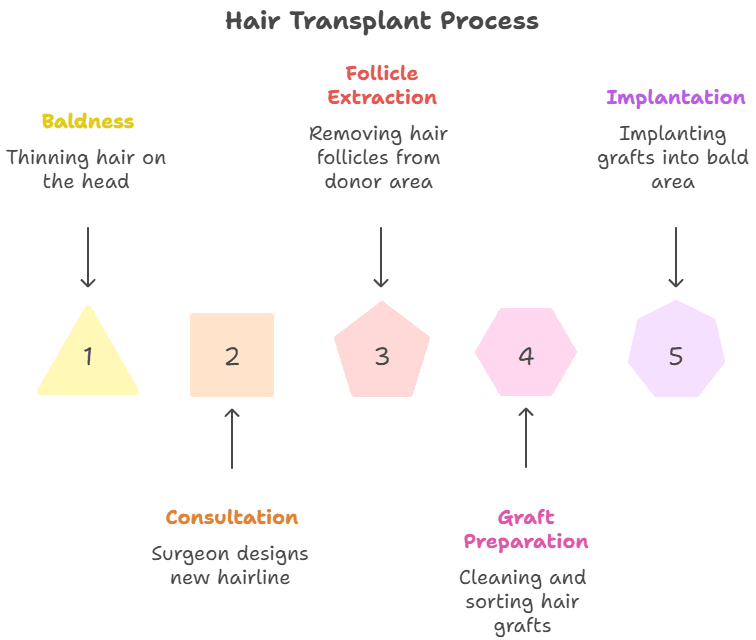Hair transplants are currently the most effective solution for baldness or thinning hair with long-term results. No matter if you have just been diagnosed with male pattern baldness or have had hair loss issues for years, modern techniques can help you get your full head of hair back. If you are just starting your research on this subject, you are probably looking to inform yourself properly. How does a hair transplant work exactly?
Well, today, we’ll learn everything about it, from the different types of hair transplant surgery to recovery times, costs, and key differences between methods.
What Is a Hair Transplant?
Let’s start with a basic definition. In a nutshell, a hair transplant is a medical hair restoration procedure in which healthy hair follicles are moved from a donor area (a part of the body with healthy hair) to bald or thinning areas of the head, with the ultimate goal of promoting natural hair growth.
Types of Hair Transplants
To help you understand how it works, let’s examine the two main types of hair transplant surgery.
- Follicular Unit Extraction (FUE): Here, the surgeon removes individual hair follicles from the donor area and implants them into the recipient area. FUE is currently the most popular method because it offers minimal scarring and faster recovery.
- Follicular Unit Transplantation (FUT): Also called the strip method, this procedure involves removing a small strip of skin hair from the donor area. The follicles are then separated and transplanted. While it may leave a small scar, you get more grafts in one session.
- Direct Hair Implantation (DHI): Uses a Choi implanter pen to place follicles directly. Offers precision and natural results but is slower and costlier.
The Hair Transplant Process: Step by Step
Let’s continue learning by examining how a modern hair transplant procedure works step by step.
- Initial Consultation and Hairline Design: Your chosen surgeon will evaluate the situation. Then, they will design a new hairline that matches your facial features.
- Preparing the Donor and Recipient Areas: Both areas are then shaved and sterilized. Then, patients get local anesthesia to make the surgery completely painless.
- Follicle Extraction: Depending on the situation and the type of hair transplant surgery, follicles are either extracted one by one or as a strip.
- Graft Preparation: The surgical team then cleans and sorts each hair graft, and they later add them to a special solution to keep them viable for the next step.
- Implantation of Hair Follicles: The head surgeon makes tiny incisions in the bald area, and implants the grafts at precise angles to ensure natural hair growth.

Recovery and Aftercare: You will need antibiotics, anti-inflammatories, and specific instructions on how to wash your hair. Most clinics provide an aftercare kit with special shampoos and a post-op neck pillow.
Does a Hair Transplant Hurt?
The short answer is no. The longer answer is that the procedure itself comes with anesthesia, so you won’t feel a thing. But it is a type of surgery, so mild discomfort, swelling, or tightness may occur afterward, but it doesn’t last long. Painkillers and proper care will minimize your issues.
Hair Transplant Recovery and Growth Timeline
Hair transplants involve the post-op process. After the procedure, if you want to know what to expect, you can check this quick table.
Timeframe | What to Expect |
Week 1 to Week 2 | The scabbing and redness will fade, and the patient can return to normal daily routines. |
Week 3 to Week 4 | During this time, your transplanted hair may shed, but don’t worry. This is normal. |
Months 3–6 | After three months, your new hair will start to grow. |
Months 6–9 | You will notice a noticeable improvement in hair thickness. |
12+ Months | It’s like the procedure never happened. Your hair will grow naturally. |
Side Effects and Risks
Generally speaking, hair transplants are risk-free, but there are instances where you need to consider some minor risks. These may include anything from infections and swelling or redness to itching, temporary shedding, and uneven hair growth. However, this side effect can be avoided if you choose an experienced surgeon with enough hair grafting experience.
How Long Do Hair Transplants Last?
If you pick an experienced surgeon and follow recovery instructions to the letter, the results will be permanent. The transplanted hair is resistant to the hormone that causes male pattern baldness, so it will continue to grow even as you age.
Choosing the Right Hair Transplant Clinic
It all boils down to you. It’s your decision, but to help you make an informed one, here’s a quick checklist to help you narrow your search.
- You want a board-certified surgeon with a proven track record.
- Take a look at the before-and-after photos on their site and consider reviews and comments by real people.
- A transparent hair transplant cost is also welcome, with clear information regarding post-op support and follow-up examinations.
Not all clinics will deliver the same level of care, and you should really consider different options to get the most bang for your buck.
A hair transplant in Turkey is currently a popular option for hair loss treatments, where top clinics, like Asli Tarcan in Istanbul, offer full-service packages that include consultation, surgery, hotel stays, VIP transfers, and aftercare, and you would be surprised when you compare prices with US and European clinics.
FAQs
What is the difference between FUE and FUT, and which is better?
The FUE method is less invasive and leaves minimal scarring, while FUT can provide more grafts in one session. FUE is more popular due to its quicker healing and natural finish.
Will people notice that I’ve had a transplant?
They won’t if you do everything by the book. Modern hair transplant techniques offer results that follow your natural hairline and density so that your new hair grows naturally.
Is a hair transplant suitable for women as well as men?
Lorem ipsum dolor sit amet, consectetur adipiscing elit. Ut elit tellus, luctus nec ullamcorper mattis, pulvinar dapibus leo.

